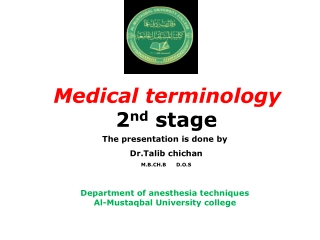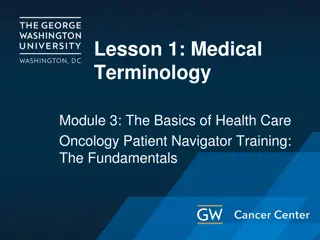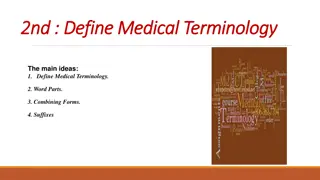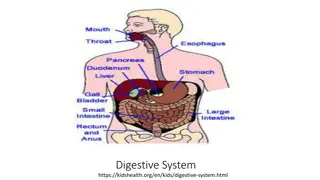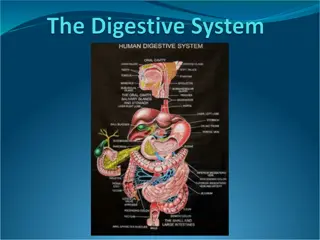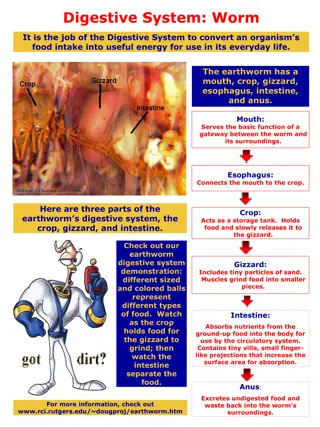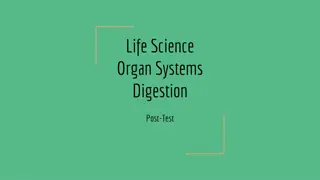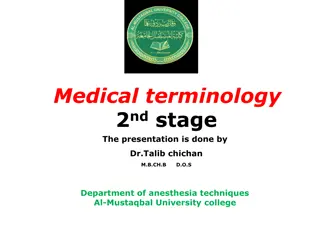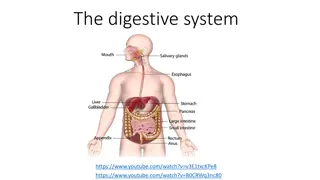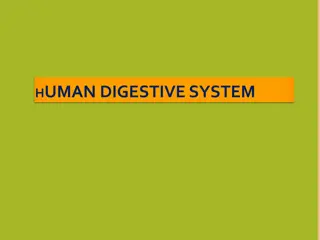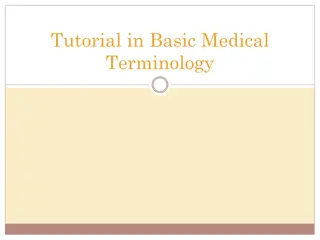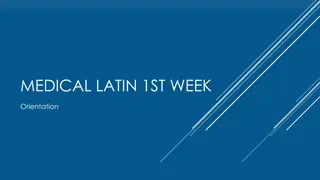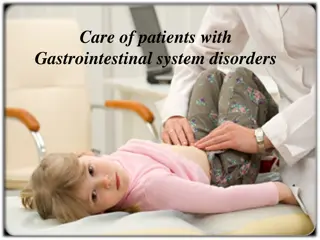Understanding the Digestive System: Medical Terminology Overview
The digestive system, comprising the gastrointestinal tract (GIT) and accessory organs, plays a vital role in digestion. From the upper GI tract (oral cavity, esophagus, stomach) to the lower GI tract (small and large intestines), each part has specific functions. Understanding salivary glands and colon divisions is essential for comprehending digestive health.
Download Presentation

Please find below an Image/Link to download the presentation.
The content on the website is provided AS IS for your information and personal use only. It may not be sold, licensed, or shared on other websites without obtaining consent from the author. Download presentation by click this link. If you encounter any issues during the download, it is possible that the publisher has removed the file from their server.
E N D
Presentation Transcript
Medical terminology The Digestive System Dr.Fadia Al-khayat
The digestive system is composed of a continuous tract beginning with the oral cavity and ending at the anus. this tract is called the alimentary gastrointestinal tract (GIT) or sometimes referred to as GI tract , in addition it is accompanied by accessory organs. (gastro or gastric = related to the stomach). The GIT is divided into two sections: a- The upper GI tract which consists of: the oral cavity, esophagus and the stomach. b- The lower GI tract which consists of the intestines. The accessory organs associated with the GIT include: the salivary glands, the liver, the gallbladder and the pancreas. canal or the
The upper GI tract: Digestion begins in the oral cavity where food is broken apart by mastication (which means chewing), then the food moves to the pharynx and then into the esophagus. The esophagus is a collapsible tube that lubricates the food and moves it to the stomach by peristalsis (which is a wave like muscular contractions that move food along the digestive tract). Then it reaches the stomach, the first area is the cardiac sphincter which is a ring like muscle that controls food flow from the esophagus into the stomach. After 3-4 hours in the stomach the food becomes in liquid form which is called chyme. Chyme passes to the small intestines through the pyloric sphincter which is a muscle at the distal end of the stomach.
The lower GI tract: It consists of the small intestines and the large intestines. The small intestine is divided into 3 parts: the duodenum, the jejunum and the ileum. The large intestine is divided into 3 parts: the cecum, the colon and the rectum. There is a blind tube attached to the cecum called the appendix which consists of lymphatic tissue. The colon is subdivided into 4 parts: the ascending colon, transverse colon, descending colon and sigmoid colon.
Salivary glands: They are present in the oral cavity, they are: the submandibular glands, the sublingual glands and the parotid glands in addition to that there are many minor salivary glands in the oral cavity. -Sial/ sialo = saliva -Sialoadenitis means inflammation of a salivary gland. -Sialostenosis means narrowing of a salivary duct. -Sialorrhea means excessive production of saliva. -Parotiditis means inflammation of the parotid gland.
The Liver: The liver is located in the upper right quadrant of the abdomen under the dome of the diaphragm.it plays important role in digestion, metabolism and detoxification (eliminating harmful and toxic substances) . -Hepat/ hepato= liver. -Hepatitis= inflammation of the liver. -Hepatomegaly= enlargement of the liver. -Jaundice or icterus= yellowish cast to the skin, sclera and mucous membranes. -Cirrhosis (cirrh means yellow) = a chronic liver disease in which the liver becomes firm and nodular.
The Gallbladder: It is located in a depression under the liver, it stores and delivers the bile to the small intestine. The gallbladder is sometimes referred to as cholecystis or cholecyst. -Cholecyst/ cholecysto= gallbladder. -Cholelithiasis (chole=gall, lith= stone, iasis= condition) = gallstones. -Cholecystitis= inflammation of the gallbladder.
The Pancreas: It is elongated feather-shaped organ that lies posterior to the stomach.it has both digestive and endocrine functions because it produces digestive enzymes and secretes hormones (the hormone is mainly insulin).
Disorders affecting the GIT: -Dysphagia: is a condition of difficulty in swallowing. -Esophagitis: is inflammation of the esophagus. -GERD (gastroesophageal reflux disease): it is the upward flow of the stomach acids into the esophagus. -Gastritis: it is inflammation of the gastric mucosa (the lining of the stomach).it may progress to ulceration if left untreated, the causes include: repeated infections, allergy to certain types of food, ingestion of spicy food, medication such as (NSAIDs). -Gastric ulcer: it is erosion of the gastric mucosa. -Dyspepsia: it means impairment of digestion.
-Appendicitis: it is a common acute inflammatory disease affecting the appendix. In some cases the appendix may rupture which can lead to a serious condition called Peritonitis which is inflammation of the peritoneum (the sac that lines the abdominal cavity). -Colitis: inflammation of the colon. -Enteritis: means inflammation of the intestines. -Enteropathy: means any disease affecting the intestines. -Cancer affects the lower GIT frequently especially the colon. -Anorexia: means loss of appetite due to psychological causes. -
Hyperemesis: means excessive vomiting. There are some diseases affecting more than one part of the digestive system , for example: -Gastroenteritis: it is inflammation of the stomach and intestines. -Gastroduedenitis: it is inflammation of the stomach and duodenum. -Enterohepatitis: it is inflammation of the intestine and liver.
Pharmacology: Antacids: drugs used to neutralize acid production. -Emetics: drugs used to stimulate or induce vomiting, frequently used in poisoning cases. -Antiemetics: drugs used to relieve vomotting.
Diagnosis: There are several devices that are used to diagnose the diseases affecting the digestive system, they include: -Colonoscope: device used in colonoscopy. -Colonoscopy: is visual examination of the colon using a colonoscope. -Duodenoscopy: visual examination of the duodenum using endoscope. -Enteroscope: lighted instrument for visually examining the intestines. -Enteroscopy: visual examination of the intestines. -Gastroscope: lighted instrument for visually examining the stomach. -Gastroscopy: visual examination of the stomach using a lighted instrument. -Sialography: radiography of salivary glands and ducts.
Practice and Practitioners: Gastroenterology: the medical specialty that is concerned with the digestive system disorders. Gastroenterologist: a specialist in the diagnosis and treatment of digestive system disorders. Internal medicine: specialty in the diagnosis and non-surgical treatment of serious and chronic illness in the abdomen including the digestive system and other organs as the liver, kidneys and others. Internist: a specialist in internal medicine. Proctologist: is a specialist in the diagnosis and treatment of rectal and anal disorders.


